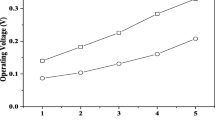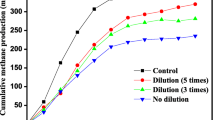Abstract
Formation of methane in the anodic chamber of a microbial fuel cell (MFC) indicates an energy inefficiency in electricity generation as the energy required for electrogenesis gets redirected to methanogenesis. The hypothesis of this research is that inhibition of methanogenesis in the mixed anaerobic anodic inoculum is associated with an enhanced activity of the electrogenic bacterial consortia. Hence, the primary objective of this investigation is to evaluate the ability of chloroform to inhibit the methanogenesis at different dosing to enhance the activity of electrogenic consortia in MFC. A higher methane inhibition and hence an enhanced performance of MFC was achieved when mixed anaerobic sludge, collected from septic tank, was used as inoculum after pre-treatment with 0.25% (v/v) chloroform dosing (MFC-0.25CF). The MFC-0.25CF attained a maximum power density of 8.51 W/m3, which was more than twice as that of MFC inoculated with untreated sludge. Also, a clear correlation between the chloroform dosing, methane inhibition, wastewater treatment, and power generation was established, which demonstrated the effectiveness of the technique in enhancing power generation in MFC along with adequate biodegradation of organic matter present in wastewater at an optimum chloroform dosing of 0.25% (v/v) to inhibit methanogenesis.



Similar content being viewed by others
References
Jiang, D., Li, B., Jia, W., & Lei, Y. (2010). Effect of inoculum types on bacterial adhesion and power production in microbial fuel cells. Applied Biochemistry and Biotechnology, 160(1), 182–196. https://doi.org/10.1007/s12010-009-8541-z.
Bhowmick, G. D., Neethu, B., Ghangrekar, M. M., & Banerjee, R. (2020). Improved performance of microbial fuel cell by in situ Methanogenesis suppression while treating fish market wastewater. Applied Biochemistry and Biotechnology. 192, 1060–1075. https://doi.org/10.1007/s12010-020-03366-y.
Huang, J., Zhu, N., Cao, Y., Peng, Y., Wu, P., & Dong, W. (2014). Exoelectrogenic bacterium phylogenetically related to Citrobacter freundii, isolated from anodic biofilm of a microbial fuel cell. Applied Biochemistry and Biotechnology, 175(4), 1879–1891. https://doi.org/10.1007/s12010-014-1418-9.
Nevin, K. P., Richter, H., Covalla, S. F., Johnson, J. P., Woodard, T. L., Orloff, A. L., & Lovley, D. R. (2008). Power output and columbic efficiencies from biofilms of Geobacter sulfurreducens comparable to mixed community microbial fuel cells. Environmental Microbiology, 10(10), 2505–2514. https://doi.org/10.1111/j.1462-2920.2008.01675.x.
Yuan, Y., Chen, Q., Zhou, S., Zhuang, L., & Hu, P. (2012). Improved electricity production from sewage sludge under alkaline conditions in an insert-type air-cathode microbial fuel cell. Journal of Chemical Technology and Biotechnology, 87(1), 80–86. https://doi.org/10.1002/jctb.2686.
Hao, L., Lü, F., Li, L., Shao, L., & He, P. (2013). Response of anaerobes to methyl fluoride, 2-bromoethanesulfonate and hydrogen during acetate degradation. Journal of Environmental Sciences (China), 25(5), 857–864. https://doi.org/10.1016/S1001-0742(12)60203-4.
Zhuang, L., Chen, Q., Zhou, S., Yuan, Y., & Yuan, H. (2012). Methanogenesis control using 2-bromoethanesulfonate for enhanced power recovery from sewage sludge in air-cathode microbial fuel cells. International Journal of Electrochemical Science, 7(7), 6512–6523. http://www.electrochemsci.org/papers/vol7/7076512.pdf. Accessed 13 Nov 2020.
Jadhav, D. A., Chendake, A. D., Schievano, A., & Pant, D. (2019). Suppressing methanogens and enriching electrogens in bioelectrochemical systems. Bioresource Technology, 277, 148–156. https://doi.org/10.1016/j.biortech.2018.12.098.
Li, W.-W., Yu, H.-Q., & He, Z. (2013). Towards sustainable wastewater treatment by using microbial fuel cells-centered technologies. Energy & Environmental Science, 7(3), 911–924. https://doi.org/10.1039/C3EE43106A.
Chen, Y., Cheng, J. J., & Creamer, K. S. (2008). Inhibition of anaerobic digestion process: a review. Bioresource Technology, 99(10), 4044–4064. https://doi.org/10.1016/j.biortech.2007.01.057.
Czatzkowska, M., Harnisz, M., Korzeniewska, E., & Koniuszewska, I. (2020). Inhibitors of the methane fermentation process with particular emphasis on the microbiological aspect: a review. Energy Science and Engineering, 8(5), 1880–1897. https://doi.org/10.1002/ese3.609.
Howland, J. L. (1995). The biochemistry of archaea (Archaebacteria). Biochemical Education, 26(2), 114. https://doi.org/10.1016/0307-4412(95)90682-7.
Chen, J. L., Ortiz, R., Steele, T. W. J., & Stuckey, D. C. (2014). Toxicants inhibiting anaerobic digestion: a review. Biotechnology Advances, 32(8), 1523–1534. https://doi.org/10.1016/j.biotechadv.2014.10.005.
Yang, J., & Speece, R. E. (1986). The effects of chloroform toxicity on methane fermentation. Water Research, 20(10), 1273–1279. https://doi.org/10.1016/0043-1354(86)90158-2.
Martinez-Fernandez, G., Denman, S. E., Yang, C., Cheung, J., Mitsumori, M., & McSweeney, C. S. (2016). Methane inhibition alters the microbial community, hydrogen flow, and fermentation response in the rumen of cattle. Frontiers in Microbiology, 7, 1122. https://doi.org/10.3389/fmicb.2016.01122.
Bauchop, T. (1967). Inhibition of rumen methanogenesis by methane analogues. Journal of Bacteriology, 94(1), 171–175. https://doi.org/10.1128/jb.94.1.171-175.1967.
Neethu, B., Pradhan, H., Sarkar, P., & Ghangrekar, M. M. (2019). Application of ion exchange membranes in enhancing algal production alongside desalination of saline water in microbial fuel cell. In MRS Advances, 4(19), 1077–1085. https://doi.org/10.1557/adv.2019.170.
Bhowmick, G. D., Das, S., Adhikary, K., Ghangrekar, M. M., & Mitra, A. (2019). Using rhodium as a cathode catalyst for enhancing performance of microbial fuel cell. International Journal of Hydrogen Energy, 44(39), 22218–22222. https://doi.org/10.1016/j.ijhydene.2019.06.063.
Neethu, B., Bhowmick, G. D., & Ghangrekar, M. M. (2019). A novel proton exchange membrane developed from clay and activated carbon derived from coconut shell for application in microbial fuel cell. Biochemical Engineering Journal, 148, 170–177. https://doi.org/10.1016/j.bej.2019.05.011.
Bhowmick, G. D., Kibena-Põldsepp, E., Matisen, L., Merisalu, M., Kook, M., Kaärik, M. M., Leis, J., Sammelselg, V., Ghangrekar, M. M., & Tammeveski, K. (2019). Multi-walled carbon nanotube and carbide-derived carbon supported metal phthalocyanines as cathode catalysts for microbial fuel cell applications. Sustainable Energy & Fuels, 3(12), 3525–3537. https://doi.org/10.1039/c9se00574a.
Neethu, B., Bhowmick, G. D., & Ghangrekar, M. M. (2018). Enhancement of bioelectricity generation and algal productivity in microbial carbon-capture cell using low cost coconut shell as membrane separator. Biochemical Engineering Journal, 133, 205–213. https://doi.org/10.1016/j.bej.2018.02.014.
APHA/AWWA/WEF. (2012). Standard methods for the examination of water and wastewater. Standard Methods, 541.
Li, X., Zhang, X., Zhao, X., Yu, B., Weng, L., & Li, Y. (2019). Efficient removal of metolachlor and bacterial community of biofilm in bioelectrochemical reactors. Applied Biochemistry and Biotechnology, 189(2), 384–395. https://doi.org/10.1007/s12010-019-03014-0.
Malvankar, N. S., Lau, J., Nevin, K. P., Franks, A. E., Tuominen, M. T., & Lovley, D. R. (2012). Electrical conductivity in a mixed-species biofilm. Applied and Environmental Microbiology, 78(16), 5967–5971. https://doi.org/10.1128/AEM.01803-12.
Cario, B. P., Rossi, R., Kim, K. Y., & Logan, B. E. (2019). Applying the electrode potential slope method as a tool to quantitatively evaluate the performance of individual microbial electrolysis cell components. Bioresource Technology, 287, 121418. https://doi.org/10.1016/j.biortech.2019.121418.
Aelterman, P., Freguia, S., Keller, J., Verstraete, W., & Rabaey, K. (2008). The anode potential regulates bacterial activity in microbial fuel cells. Applied Microbiology and Biotechnology, 78(3), 409–418. https://doi.org/10.1007/s00253-007-1327-8.
Logan, B. E. (2007). Microbial fuel cells. Hoboken: John Wiley and Sons. https://doi.org/10.1002/9780470258590.
Friman, H., Schechter, A., Ioffe, Y., Nitzan, Y., & Cahan, R. (2013). Current production in a microbial fuel cell using a pure culture of Cupriavidus basilensis growing in acetate or phenol as a carbon source. Microbial Biotechnology, 6(4), 425–434. https://doi.org/10.1111/1751-7915.12026.
Funding
The research project was supported by Department of Biotechnology, Ministry of Science and Technology, Government of India (BT/EB/PAN IIT/2012) providing the financial assistance.
Author information
Authors and Affiliations
Corresponding author
Additional information
Publisher’s Note
Springer Nature remains neutral with regard to jurisdictional claims in published maps and institutional affiliations.
Rights and permissions
About this article
Cite this article
Tholia, V., Neethu, B., Bhowmick, G.D. et al. Enhancing the Performance of Microbial Fuel Cell by Using Chloroform Pre-treated Mixed Anaerobic Sludge to Control Methanogenesis in Anodic Chamber. Appl Biochem Biotechnol 193, 846–855 (2021). https://doi.org/10.1007/s12010-020-03458-9
Received:
Accepted:
Published:
Issue Date:
DOI: https://doi.org/10.1007/s12010-020-03458-9




